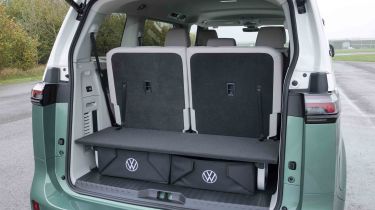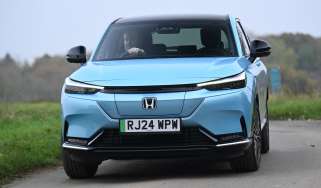Volkswagen ID. Buzz - Boot space, comfort & practicality
The standard ID. Buzz is great for practicality, but the long-wheelbase version takes things to another level

The five-seat Volkswagen ID. Buzz offers decent practicality, but the extended LWB model is even more versatile. Not only is it a seven-seater, but it has a sliding bench that boosts versatility even further.
The sliding side doors help by making access to the back seats easier in tight spaces than it would be with a traditional hinged car door. The tall roof should mean you won't bump your head putting a child in their car seat.
There’s no shortage of cubbies or storage spaces throughout the cabin. For example, the central compartment below the air vents opens to reveal cup holders and storage for smartphones.
Another useful addition to the front cabin is the ‘Buzz Box’. This is a removable centre console between the front seats with deep storage compartments. It latches securely to mounting points in the floor between the front seats, or you can remove it completely if you want.
| Dimensions | |
| Length | 4,712-4,962mm |
| Width | 1,985mm |
| Height | 1,924mm |
| Number of seats | Five to seven |
| Boot space | 306-1,340 litres |
Dimensions and size
The Volkswagen ID. Buzz measures 4,712mm long as standard and 4,982mm in LWB guise, which means it’s a millimetre longer than the ID.7 executive, and the only longer VW car is the Multivan people carrier. Factor in the ID. Buzz’s 1,985mm roof height, and that means it’s a lot bigger in real life than you might assume from pictures, especially if the old Type 2 is your point of reference. That’s still low enough for the car to fit in most multi-storey car parks, although you might find yourself instinctively ducking under low beams. All versions of the ID. Buzz are 1,985mm wide, which is a fair bit narrower than large SUVs like the Land Rover Discovery, so urban width restrictions should largely be manageable
How practical is the Volkswagen ID. Buzz?
Seats & space in the front
There’s lots of room for two up front in the ID. Buzz, while the vast windscreen and light cabin colours boost the sense of space. Storage is van-like, with big double door bins, trays on the dashboard, a good glovebox and an opening cup-holder lower down. The Buzz Box centre console includes cup-holders, an ice scraper/bottle opener and additional drawers, and can be removed completely if necessary.
Seats & space in the back
Access to the back is easy via the wide sliding doors, and once inside there’s plenty of head and legroom. The seating layout has a 60:40 split, so the three chairs don’t slide individually, while the middle seat is a little narrow, but there’s legroom even with the chairs moved fully forward.
Used - available now

2018 Audi
Q7
52,994 milesAutomaticDiesel3.0L
Cash £24,920
2022 SEAT
Tarraco
59,470 milesManualDiesel2.0L
Cash £17,920
2021 Ford
Fiesta
22,611 milesAutomaticPetrol1.0L
Cash £14,220
2025 BMW
i4
23,394 milesAutomaticElectric
Cash £28,220There are now air vents located in the roof to help keep those in the back cool on a hot day, while USB sockets feature in the doors, where there are also deep storage pockets. The ID. Buzz shows its van roots here again by having fixed rear windows that don’t open in Life spec, although they do open on Style and GTX cars.
The long-wheelbase version of the ID. Buzz eliminates one of the chief criticisms we had of the car when it was first launched, because the sliding seats transform the VW’s versatility. The mechanisms are a little stiff to use, but once you’ve got the hang of them, you can move the seats into any layout that you need. All of the seat backs can be positioned upright for boot space or reclined for comfort.
The rearmost two seats slide, and there’s enough legroom for adults to get comfortable. However, although headroom is good in most positions, if you push the seats fully back, there’s a bulge in the roof where the tailgate mechanism is located that restricts headroom for taller occupants. There are two USB-C sockets in the back, plus cup-holders.
Boot space
Even with the rearmost row of seats pushed all the way back, there’s still a reasonable amount of space for luggage. A capacity of 306 litres is about the same as a supermini’s, so you could get some shopping in there if you needed to.
The Multiflex system creates under-floor storage with two drawers, while folding the back seats leaves a completely flat load area, although there are gaps in the floor if the seats are pushed forward when they’re flat. The floor hinges up to improve access to the fabric drawers that slot beneath, too. If you want maximum volume, the rearmost two seats are removable. There’s just one bag hook in the boot, but Volkswagen also provides a plastic divider with a Velcro-style strip that can be attached to the floor in various positions to help divide the space.
Towing
If you want to use the Volkswagen ID. Buzz to tow, you need the GTX version. It can lug around a braked trailer or caravan of 1,800kg in SWB form, or 1,600kg in LWB form. The rest of the range improves upon the 1,000kg braked towing rating of the original ID. Buzz by increasing capacity to 1,200kg. However, that's still less than some far smaller EVs like the Volvo EX30, which can handle up to 1,600kg.
VW offers a retractable tow bar with electric release as an option for around £1,000.











